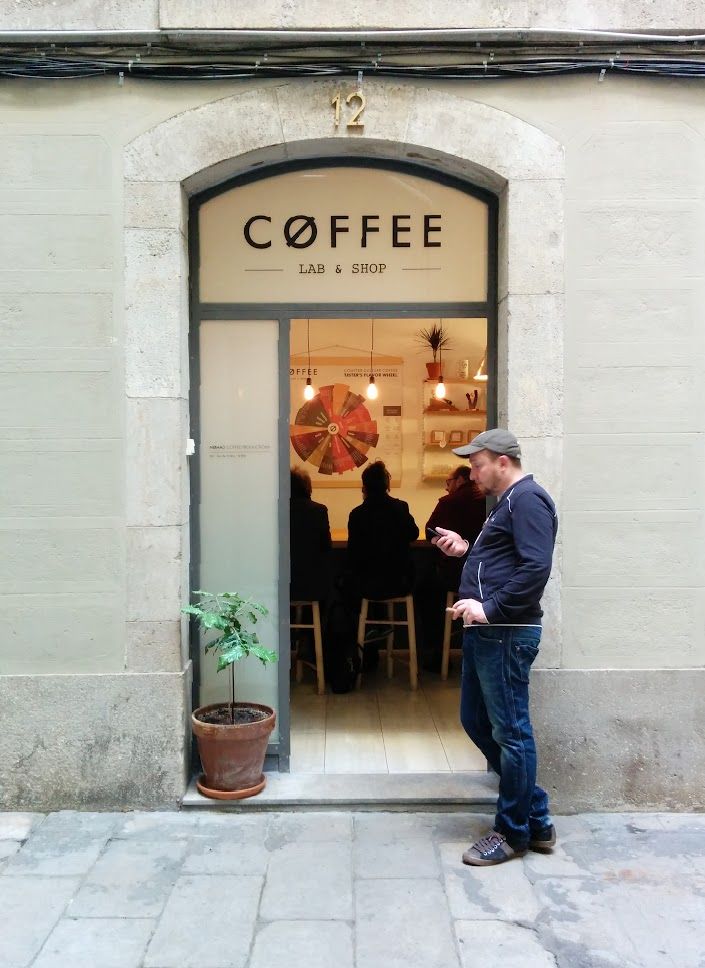Stacking spaces
3/8/2025 ☼ uncertainty ☼ urban planning ☼ cities ☼ innovation ☼ retail
tl;dr: Hidden behind an unmarked doorway in Barcelona, two coffee businesses share the same small space — one roasting and selling, the other teaching and tasting — but not at the same time. This smart setup, which I called a stacked space, cuts costs, spreads downside-exposure, and promotes urban experimentation and innovation. It’s an emerging pattern you can now spot in Singapore, Tokyo, Manhattan, and Paris … and a kind of urban innovation planners and developers haven’t caught onto yet, but should.
On two visits, we met two different halves of the Cøffee Lab and shop on Passatge Sert in Barcelona. But we only found this out by accident.
 Cøffee Lab; 28 March, 2014.
Cøffee Lab; 28 March, 2014.
The first time we visited, Jordi Mestre, owner of Nomad Coffee, made us a V60 out of a prototype roast of Colombian beans from La Esperanza — the profile was light as is the mode these days, but sweet too, with red fruit.
 Jordi Mestre makes a V60 from La Esperanza; 28 March, 2014
Jordi Mestre makes a V60 from La Esperanza; 28 March, 2014
On our second visit, Kim Ossenblok made us a Chemex from Kenyan beans from Kochere roasted by Nomad (intense blueberry, as is sometimes the case). As he poured, one of us asked if he was a partner in Nomad. Of course not.
Turns out, Kim runs a cupping and training studio. In the same space, during only partly overlapping hours, Nomad also has a retail space and coffeeshop. Kim tells us it is “like a coffee coworking space,” but it isn’t really coworking.
 Kim Ossenblok makes a Chemex from Kochere; 31 March, 2014
Kim Ossenblok makes a Chemex from Kochere; 31 March, 2014
We don’t have a good word or phrase yet to describe an arrangement in which multiple businesses occupy the same space at different times of the day or week (or even the year). So I’m going to coin one: Let’s call them stacked spaces.
Kim says, “It is a good way to have a physical space to work. For me, a space to teach about coffee. For Jordi [from Nomad], a place to show his coffee. It’s not always easy to find people you can share a space with, but we are lucky. It works. I have what I need, Jordi has what he needs. The cafe doesn’t even have to be so profitable because we’ve all got something else going on … it is more efficient to use the space this way.”
Stacked spaces reduce rental cost and operational risk for the businesses that occupy them. Many East Asian and Southeast Asian cities have acquired stacked spaces purely out of a combination of laissez-faire regulation, high rents, and dense population — and in cities like Singapore or Tokyo, stacked spaces contribute to urban vitality and adaptability.
Similar patterns are now emerging in Manhattan, London, and Paris, mostly in the interstitial spaces that are not carefully managed or regulated in conventional ways. So far, stacking spaces is a practice driven by small entrepreneurs trying to find ways to make unusual or emerging businesses viable to start and (maybe) to scale.
This is the shape of one type of highly desirable urban innovation, and it tends to only be possible in places where regulation and real estate convention enables what I call structured mess in urbanism.
City planners, city governments, large property developers, and property managers are not yet systematically in on this game of stacking spaces (or even creating structured mess) — but they really should be.
The original note was written in April 2014 from visits in March 2014. Since then, Nomad has taken over the Cøffee Lab space for Nomad Coffee Bar, and Kim now runs his coffee training facility online.
For the last few years, I’ve been wrestling with the practical challenges of meaning-making in our increasingly AI-saturated world, developing frameworks for how humans can work effectively alongside these powerful tools while preserving the meaning-making work that is the irreplaceably human part of the reasoning we do. I’ve published this as a short series of essays on meaning-making as a valuable but overlooked lens for understanding and using AI tools
I’ve also been working on turning discomfort into something productive. idk is the first of these tools for productive discomfort.
And I’ve spent the last 15 years investigating how organisations can succeed in uncertain times. The Uncertainty Mindset is my book about how to design organisations that thrive in uncertainty and can clearly distinguish it from risk.